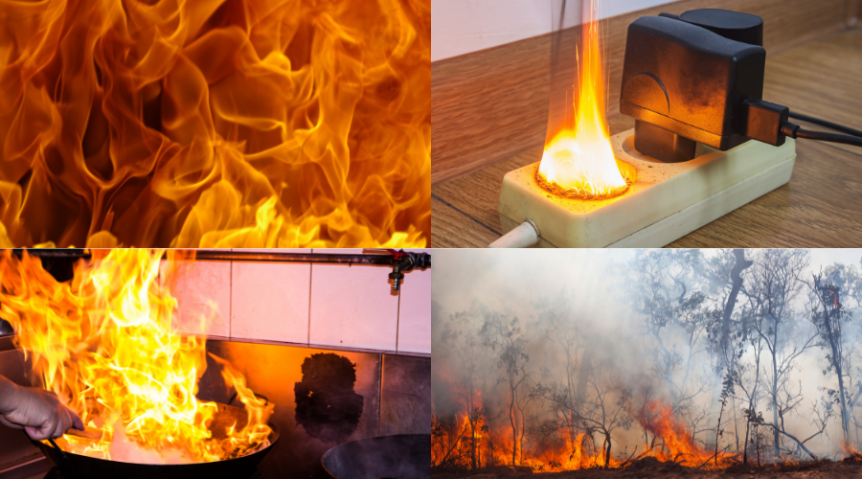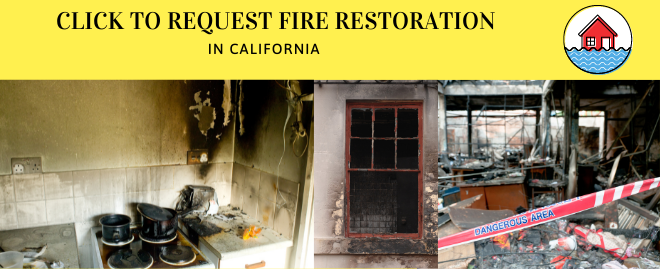When a fire occurs, it must be extinguished immediately to prevent it from spreading and limit the damage. While many people may think they can extinguish a fire by grabbing the nearest fire extinguisher or throwing water on it, this is not always the case. There are five different classes of fires, and each of these classes requires specific methods and types of fire extinguishers to put out the flames.
Fires are classed into certain categories based on the fuel source of the fire. The best way to keep your home or business safe is to have multiple classes of fire extinguishers and equipment so you can effectively put out any type of fire you encounter. In general, Class A fires should be put out with water, Class B fires must be smothered with a chemical, Class C fires must be put out by cutting off the oxygen supply, Class D fires can be put out by breaking the chain reaction, and Class K fires require chemical fire extinguishers.
In this guide, we will discuss the different classes of fires as well as how to extinguish them, including which class fire extinguisher should be used for each type of fire.
How to Distinguish the Class of Fire
Fire classification is the process of assessing the severity of a fire based on factors like temperature and fuel type in a specific area. Fires are categorized into four primary levels: A, B, C, and D, with Level A representing the least severe and Level D the most intense. These classifications help firefighters determine the appropriate equipment and strategies needed to manage and extinguish the fire effectively. Additionally, there is Class K, which refers specifically to fires involving electrical equipment not linked to electricity generation, transmission, or distribution.
The key to identifying the class of a fire is the color of the flames. Red, orange, and yellow flames indicate that there are carbon compounds burning in the organic material. Blue flames indicate that something with high carbon content has caught on fire, such as oil or wax, but it does not necessarily mean that the flame has spread to other materials or will become more intense. Fire classes can also be distinguished by shape, pattern, movement, and intensity.
A wide range of substances are used to extinguish different types of fires, from basic fuels like wood and paper to more complex ones such as petrol and other flammable liquids. Here’s an overview of common fire extinguishers and their applications:
- AFFF (Aqueous Film Forming Foam): Ideal for class A fires involving materials like wood, paper, or fabric, this agent creates a film that smothers the fire and prevents re-ignition.
- BAFF (Bromotrifluoromethane): Similar to BFF or TFF agents, this extinguisher uses fluor ethane instead of trifluoroethane, making it effective for certain specialized fire scenarios.
- CO2 (Carbon Dioxide): Commonly used for class B fires involving flammable liquids like petrol or diesel, CO2 extinguishers reduce oxygen levels to smother the fire effectively.
- HEPA Filter Cartridges: These electrostatic precipitators are often used in non-pyrotechnic smoke hoods, providing protection against flammable gas fires.
By understanding the specific properties of each extinguisher, you can ensure the right tools are used for each fire type, improving safety and effectiveness in emergency situations.
Class A Fires – Extinguish with Water
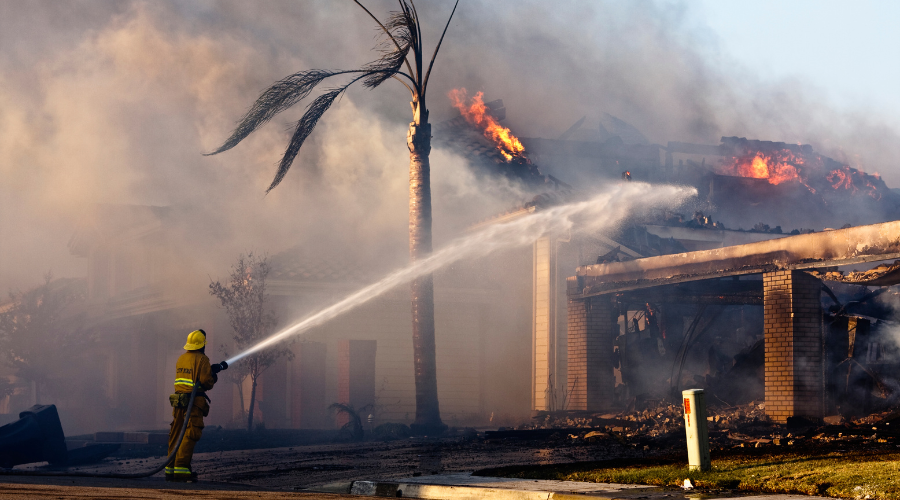
CALL SERVICE MASTER 24 HOURS A DAY AT (800) 439-8833 FOR FIRE RESTORATION SERVICES
The first type of fire is a Class A fire, which originates from common combustible materials such as wood, paper, fabric, trash, and plastics. These fires often occur accidentally, with trash and dumpster fires serving as prime examples. While such fires typically pose minimal risk to the general public, they can be hazardous for those attempting to extinguish them. Anyone responding to these situations should take extreme precautions to protect themselves.
Class A fires can be effectively extinguished using water or mono ammonium phosphate. For water-based extinguishing, a continuous stream of water should be directed at the fire to cool and suppress the flames. However, responders should keep their distance as the fuel of the fire may include combustible or hazardous materials that could explode unexpectedly. If hazardous materials are suspected, it’s critical to contact local environmental specialists for assistance.
Water is an effective fire suppressant because it absorbs significant amounts of energy, transferring heat away from the fire and preventing combustion. This method works best when there is no immediate need to remove fuel or oxygen from the fire. By cooling the burning material, the rate of heat release is slowed, ultimately extinguishing the flames. Liquids like water or foam that conduct heat effectively are commonly used for this purpose.
To cool a fire, water can be sprayed directly onto the burning material. By applying a large volume of water, heat is conducted away from the flames, lowering the material’s temperature and halting the combustion process. However, this method is not flawless. When water vaporizes, it generates some heat, and there is often a slight delay between applying water and fully extinguishing the fire.
Among fire extinguishing agents, water remains the most versatile and widely used. It is abundant, affordable, non-toxic, and highly efficient at absorbing heat. By cooling burning materials and restricting oxygen access to flames, water serves as a reliable and effective means of extinguishing Class A fires.
Class B Fires – Extinguish by Depleting Oxygen
Class B fires are caused by the combustion of flammable liquids or gases. Examples of flammable liquids include petroleum-based oils, paints, tars, alcohol, solvents, gasoline, and kerosene. Flammable gases, such as butane and propane, are also common culprits. Industries that regularly handle these substances must take extra precautions to prevent accidental ignition of the fuels, lubricants, or paints they work with daily.
To extinguish a Class B fire, smothering the flames is essential. This method deprives the fire of oxygen, effectively starving it and extinguishing the flames. Dry chemicals like ammonium phosphate or pressurized carbon dioxide are highly effective tools for combating these types of fires.
Important: Never use water to extinguish a Class B fire. Water can cause flammable liquids to splash, spreading the fire and worsening the situation. Instead, focus on cutting off the fire’s oxygen supply to suffocate it. This can be achieved by sealing off the source of fresh air or allowing the fire to naturally deplete the oxygen in a confined space until it self-extinguishes.
Proper understanding and handling of Class B fires are critical for industries that work with flammable liquids and gases. By following these methods, you can effectively prevent and respond to such fires while ensuring workplace safety.
Class C Fires – Extinguish by Cutting Power
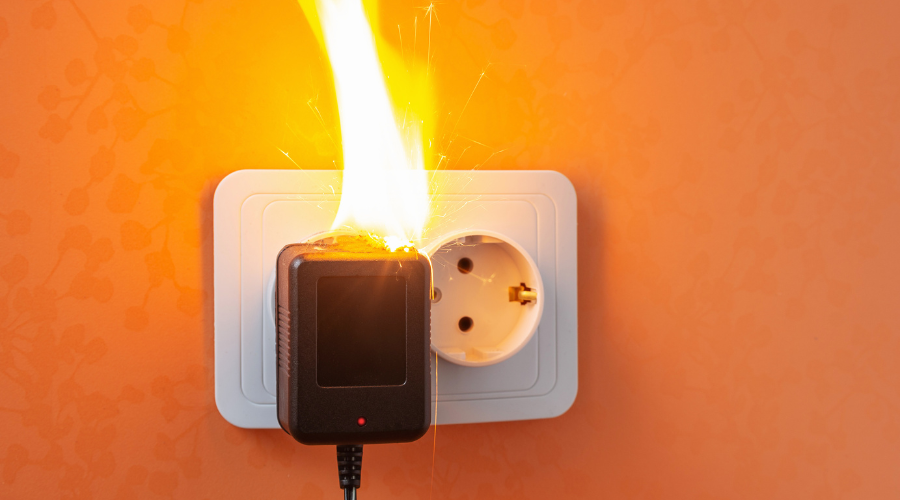
Electric fire – contact ServiceMaster of San Francisco at (800) 439-8833 for fire emergency restoration
Class C fires, also known as electrical fires, are caused by electrical components such as transformers, appliances, and motors. Electrical fires are a leading cause of house fires with an estimated 51,000 electrical fires occurring each year, resulting in around $1.3 billion in property damage.
Industries dealing with large-scale electrical equipment are more likely to encounter Class C fires, but smaller businesses and homes are also at risk. Faulty wiring, overloaded surge protectors, and outdated appliances can all trigger these fires. In homes, space heaters and aging electrical systems are common culprits.
To extinguish a Class C fire, the first step is to cut off the electrical power, which acts as the fire’s fuel source. Non-conductive extinguishing agents, like carbon dioxide, should then be used to suppress the flames safely.
By understanding the unique nature of Class C fires and how to address them, businesses and homeowners can better prepare to handle these dangerous situations safely and effectively.
Class D Fires – Extinguish with Dry Powder Agents
Class D fires are caused by combustible metals such as titanium, magnesium, sodium, lithium, aluminum, and potassium. These types of fires are most commonly found in laboratory environments where such materials are handled.
Never use water to extinguish a Class D fire. Water can intensify the flames, as it reacts dangerously with certain metals, often causing the fire to burn more aggressively. Instead, dry powder agents are the recommended extinguishing method. Effective options include graphite powder, powdered copper, and sodium chloride. These agents work by absorbing heat and smothering the flames, making them highly effective for controlling and extinguishing Class D fires.
It’s important to note that dry powder agents are not the same as dry chemical agents. Using dry chemicals on a Class D fire could worsen the situation and increase the fire’s intensity. Always ensure you are using the appropriate dry powder agents specifically designed for metal fires.
Additionally, certain extinguishers like dry powder, Bromochlorodifluoromethane (BCF), and other halon-based agents are particularly useful for flammable liquid fires. These extinguishers neutralize the chemical chain reaction without leaving residue, making them non-toxic, environmentally safe, and ideal for protecting valuable equipment, fixtures, wall coverings, and artwork. These features ensure both safety and the preservation of high-value assets.
Class K Fires – Extinguish with Chemical Fire Extinguishers

Class K fires are cooking fires caused by grease, lard, olive oil, butter, animal fats, or vegetable fats. These types of fires are a significant risk in commercial kitchens and restaurants but can also occur in homes. A Class K fire often ignites on stovetops, ovens, or grills when grease splatters onto a heat source. Even overheated food in a microwave can trigger a cooking fire.
The best way to extinguish a Class K fire is by using a chemical fire extinguisher. These extinguishers contain agents that absorb heat, cut off oxygen to the flames, and effectively smother the fire. Both homes and commercial kitchens should be equipped with fire extinguishers, and anyone working in the kitchen should know how to use them properly. Chemical fire extinguishers are categorized into two main types: water-based and powder-based. Water-based extinguishers, often using CO2, are particularly effective because the carbon dioxide removes oxygen from the fire zone, which is crucial for combating fires involving oxidizing agents like flammable gases.
In the event of a Class K fire, follow these steps to ensure safety and containment:
- Do not attempt to move the fire. Moving it can cause it to spread to other areas.
- Shut off nearby oxygen sources. Close ventilation systems, windows, or anything else that could feed the fire with oxygen.
- Use water spray or foam. Aim directly at the source of the fire to control the flames and disrupt the chemical reaction.
By being prepared and understanding the proper steps to handle a Class K fire, you can significantly reduce the risk of escalation and protect your home or workplace.
Professional Fire Damage Restoration
Understanding the different classes of fires and how to extinguish them is essential for protecting lives and property. Each fire class—A through K—requires specific approaches and tools, and using the wrong method can worsen the situation. Whether at home or in a commercial setting, having the proper fire extinguishers and knowing how to use them can make all the difference in an emergency. By staying informed and prepared, you can respond quickly and effectively to fire incidents, minimizing damage and enhancing overall safety.
If fire or smoke has impacted your home or business, turn to your trusted local fire damage restoration experts. ServiceMaster DRR combines cutting-edge equipment with proven techniques to deliver comprehensive fire damage cleanup and restoration services. When smoke lingers and soot leaves its mark, our skilled technicians are just a call away at (800) 439-8833. Fully licensed and insured, our fire damage specialists will promptly assess the damage and implement a strategic plan to restore your property to its pre-loss condition efficiently and effectively.
ServiceMaster DRR reliably serves the San Francisco, CA community of residential homes and businesses 24 hours a day, 7 days a week. When any type of fire sparks, don’t hesitate to contact the area’s most trusted and responsive fire damage restoration professionals, ServiceMaster DRR, for a thorough cleanup and a full restoration of your property.
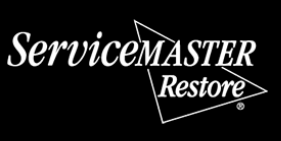
Steve VanDenBerg is the owner of ServiceMaster Disaster Restoration and Recovery. He has over 30 years of experience working within the restoration industry and successfully leading start-ups, turnarounds, acquisitions and mergers, and rapidly growing companies.
Steve earned his BS in Business & Accounting from Calvin University in Grand Rapids, MI and began working for DSI Holdings as their Chief Financial Officer. When Steve began with DSI Holdings, they were running an underperforming ServiceMaster Restore franchise with one location. Steve implemented new policies and procedures for accounting and finance as well as a professional sales plan that increased profits eightfold over his time as the CFO. He was then promoted to President and CEO and in this time, he expanded the company from two locations with $4M in sales to 12 locations and $45M in sales. DSI Holdings became one of the largest disaster restoration companies in the U.S. and helped with major restoration projects throughout the U.S. and around the world.
Steve purchased ServiceMaster DRR in 2015 when the business was in decline. Drawing on his years of experience in turning around struggling ServiceMaster franchises, Steve overhauled our operations, including finance, sales, and marketing, which led to a quick turnaround. Within Steve’s first 24 months, sales increased by 60 percent. Steve also helped greatly improve our operating margins and established a relationship with California’s largest residential insurance company. Under Steve’s leadership, we have become one of the largest disaster restoration providers in California.
Steve has found great success in turning around struggling and stagnant restoration franchises by changing the business model and strategy, greatly increasing sales and profits. Many of the changes he has implemented have even been adopted by the franchisor into their operating model.



